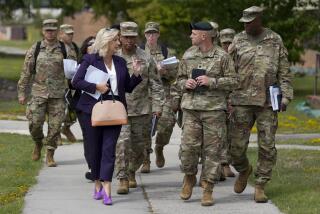Army to Bolster Its Ranks
WASHINGTON — With wars in Iraq and Afghanistan straining the U.S. Army, commanders will add more than 1,000 recruiters and more than double bonuses for new enlistees as part of an aggressive effort to shore up force levels, Pentagon officials said Thursday.
Army officials say they plan to meet recruiting targets of 77,000 soldiers for 2004, but are undertaking the extra steps to ensure continued recruitment through 2005, as the wars continue and extended tours of duty rattle those considering reenlistment.
“What we’re working on now is priming the pump for fiscal 2005,” said Douglas Smith, a spokesman at the Army Recruiting Command at Ft. Knox in Kentucky.
The new recruiters are a key part of the campaign. To persuade prospective soldiers, the Army is increasing the number of active-duty and reserve recruiters from about 6,000 to more than 7,000 by year’s end, Army officials said. The force of active-duty recruiters will rise from 5,111 to 6,029, officials said, and the number of recruiters for the Army Reserve will rise from 954 to 1,062.
Officials at the Army Recruiting Command said bonuses would rise to a maximum of $15,000 for soldiers willing to sign up for a 3-year stint in understaffed jobs -- more than doubling the previous maximum bonus of $6,000.
Many of those posts are in the war zones. Soldiers can earn as much as $9,000 in bonuses by becoming petroleum supply specialists and food service operators.
There are also bonuses for education: $8,000 for soldiers holding a bachelor’s degree, $7,000 for a two-year college degree and $6,000 for a high school diploma. Depending on the job, bonuses of as much as $9,000 will be paid to recruits who report to basic training by Sept. 27. Civilians who bring special skills can add an additional $3,000.
Although the measures could help the Army meet short-term goals, some analysts questioned how long a widely dispersed Army could keep it up while also relying heavily on forced-duty extensions -- called “stop-loss” programs -- and repeated returns to combat.
“Morale is still pretty good in the Army and people are still willing to join,” said Michael Vickers, a former Green Beret and CIA operations officer now with the Center for Strategic and Budgetary Assessments in Washington.
“But there are a lot of expedient measures that you just can’t sustain over time, like the stop-loss. And people are rotating back to Iraq too rapidly.”
Pentagon officials once predicted that they could reduce the number of U.S. troops in Iraq to about 100,000 by now. But of 160,000 non-Iraqi troops in the country, 138,000 are Americans, and most of those are from the Army.
As personnel strains have deepened, the Army has resorted to an array of measures to maintain force levels while meeting other global commitments.
First, early in the Iraq war, came the “stop-loss” orders barring troops from leaving during wartime. Then came the bonuses. Next, the Army moved up the enlistment dates of troops scheduled to begin training in 2005 and offered incentives to troops willing to trade their Air Force blues and Navy whites for Army green.
The Army is surpassing 2004 recruiting goals even though they were raised from 72,500 to 77,000, with one exception: The Army National Guard expects to reach 88% of its goal for 2004.
More to Read
Sign up for Essential California
The most important California stories and recommendations in your inbox every morning.
You may occasionally receive promotional content from the Los Angeles Times.










